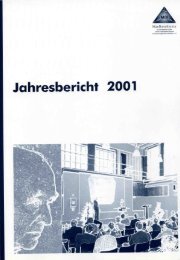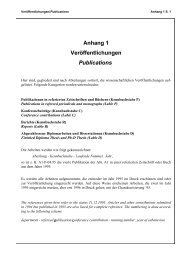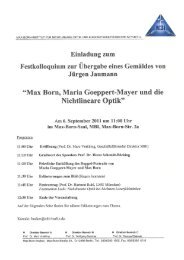You also want an ePaper? Increase the reach of your titles
YUMPU automatically turns print PDFs into web optimized ePapers that Google loves.
36<br />
Fig. 5<br />
A sketch of a 5 femtosecond<br />
800 nm optical pulse.<br />
Splitting the electron<br />
<strong>Max</strong> <strong>Born</strong> • Paul Corkum<br />
Thanks to the laser, we have gained the ability to directly measure very short time intervals.<br />
We usually do this by using very short laser pulses. These pulses operate like strobe lights in<br />
a disco, but in the case of lasers, atoms and molecules inhabit the disco floor.<br />
Figure 4 shows a time line of the duration of laser pulses. It shows that we have just passed<br />
an important milestone – we can now make optical pulses that have durations measured in<br />
attoseconds [5, 6]. The attosecond time scale is especially promising because it is the scale on<br />
which electrons move. An electron in a hydrogen atom completes its Bohr orbit in 150 attoseconds.<br />
Pulses shorter than this will allow us to “freeze electron motion” in hydrogen.<br />
As I tell you about imaging electrons I will automatically also tell you about how attosecond<br />
pulses are generated and the science that underlies their generation. This area of science is<br />
rapidly gaining the name “attosecond science” because it grows out of “ultrashort pulse” science<br />
– (pre-attosecond science).<br />
Light is actually a wave of force on a charged particle. We speak of this force as an electric<br />
field. It is a field (like a farmer’s field) because a wave, by its very nature, cannot be confined<br />
to a point, but must undulate over an extended region of space. Figure 5 is an image of a<br />
5-femtosecond light pulse. This is the shortest pulse that can be produced using conventional<br />
laser technology. Although one axis of the graph represents time, you can also think of Fig. 5<br />
as an image by simply multiplying time by the speed of light. Then 2.7 femtoseconds is equivalent<br />
to 0.8 microns (or 8/100,000 cm). The light’s field in Fig. 5 is confined to a few microns<br />
in space along its propagation direction.<br />
Figure 6 depicts the potential that an atom’s electron would experience while immersed in the<br />
light wave. (Everything that I say about Figs. 6 and 7 would be much the same if the image<br />
were a molecule.) The electron is confined to an atom in much the same way that water is confined<br />
inside a glass. Of course, the “sides of the glass” are not physical in the electron’s case.<br />
Instead, the electrons are confined to the atom by the Coulomb attraction between the negative<br />
charge of the electron and the positive charge of the ion. The laser field tips the glass. You<br />
can see the lip through which the electron could escape.<br />
Figure 7 is a one-dimensional cut through the atom in Fig. 6. By simplifying the figure, I have<br />
space to show the electron wave that is confined by the atom (technically, the atom’s wavefunction).<br />
In Fig. 7, the wave covers only 1/2 oscillation and is labelled by the symbol Ψ g. You<br />
might think of the electron bouncing back and forth in the glass or oscillating like the string of<br />
a violin. The image shows its blurred position.












